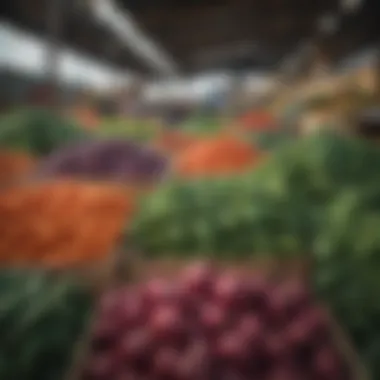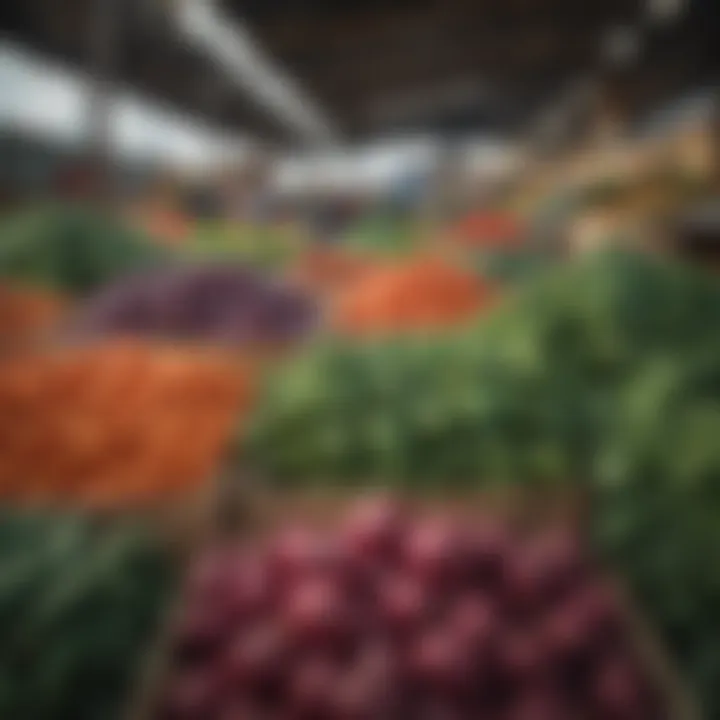Exploring Local Produce: A Practical Guide


Intro
In recent years, a growing fascination with local produce has taken root across communities. Many individuals seek not only fresher, more flavorful food but also a connection to the local agriculture that provides it. This interest goes beyond personal taste; it taps into the broader desires for sustainability, support for local farmers, and a healthier lifestyle. The local produce landscape is rich with opportunities, and understanding how to navigate it can bring numerous benefits.
Topic Overview
Definition and Importance
Local produce refers to food grown in one's community or region, typically sold through farmers' markets, community-supported agriculture (CSA), or directly from farms. The importance of sourcing local food cannot be overstated. By choosing local, consumers can enjoy foods that are fresher, often harvested at the peak of ripeness, thus maximizing taste and nutrition. Furthermore, buying local helps reduce the carbon footprint associated with long-distance transportation and supports local economies.
"Choosing local food is not just a dietary choice; it’s an investment into the community and the ecosystem."
Brief History and Evolution
Historically, prior to the industrialization of agriculture, local sourcing was the norm. Families relied on local farms for their daily food needs. However, as farming methods advanced and globalization took hold, food systems became increasingly centralized. This shift often prioritized quantity over quality. In recent decades, there has been a resurgence in the appreciation of local farming practices. Initiatives promoting farm-to-table dining experiences and strong community ties have highlighted the benefits of returning to local sources for food.
Key Techniques and Innovations
Sustainable Farming Practices
Sustainable farming methods are crucial for maintaining long-term soil health and natural ecosystems. Many local farmers adopt practices such as crop rotation, cover cropping, and organic farming. These techniques not only enhance the quality of produce but also ensure that farming is viable for future generations.
Advanced Agronomic Technologies
Emerging technologies in agronomy also play a role. From precision farming techniques that utilize data to maximize crop yield, to developing vertical farms in urban areas, innovation is pivotal in modern agriculture. Such advancements empower local farmers to compete better in an increasingly commercialized market while still holding onto their values of sustainability and quality.
Practical Applications
Step-by-Step Guides
- Research Local Farmers: Find out which farms are available in your area. Use social media platforms, such as Facebook or local community groups on Reddit, to connect with producers.
- Visit Farmers' Markets: Spend some time at nearby markets to familiarize yourself with what’s available seasonally.
- Join a CSA: Engage with community-supported agriculture. This can provide you with a steady supply of fresh produce throughout the growing season.
- Support Local Restaurants: Dine at eateries that prioritize local sourcing.
Case Studies or Real-World Examples
Consider the case of Blue Sky Farms situated in the outskirts of a bustling city. The owners have embraced organic farming and established a successful CSA within three years. Their innovative practices show how a focus on local can not only nurture the soil but also create a thriving business model. Community feedback has been overwhelmingly positive, with many locals eager to support a farm that prioritizes quality and sustainability.
By understanding the dynamics of local produce sourcing and the dedicated efforts of farmers, consumers can make informed choices that benefit both their health and the community. As this movement continues to grow, the local produce landscape offers delightful possibilities for everyone involved.
Understanding Local Produce
Understanding the concept of local produce serves as the backbone of a healthier and more sustainable food system. It reflects not just a commitment to quality but also to community welfare, where the flavors of the earth entwine with the spirit of local economies. By fostering relationships with nearby farms and markets, individuals contribute to a food culture that’s rooted in place, contributing to a sense of belonging and shared responsibility.
Definition and Importance
Local produce can be defined as any food item that is grown or cultivated within a certain radius of its point of sale to consumers. Though the exact distance can vary, some define local as anything produced within 100 to 250 miles. The importance of this type of sourcing cannot be overstated. When you opt for local produce, you’re not only supporting the local economy but also ensuring fresher food choices.
Freshness is a key factor here. When produce is harvested and brought to market quickly, it retains more nutrients and flavor. A tomato picked just hours before being sold packs a punch of flavor and vitality compared to one that’s traveled thousands of miles. Furthermore, buying local contributes to reduced transportation costs and carbon footprint, bringing sustainability into play.
"When you choose local, you don’t just eat. You vote – with your fork."
Embracing local produce cultivates a sense of community among consumers and farmers alike. Every time someone purchases food direct from a farmer or a local market, it strengthens the ties that bind a community together, nurturing economic resilience.
Impact on Health and Nutrition
The connection between local produce and health is undeniable. The shorter distance from farm to table not only enhances taste but also nutritional value. Local farmers often grow varieties that are more nutritious as they can choose to plant what flourishes in their area without being swayed by mass-market demands.
Here are key health benefits to consume locally sourced produce:
- Higher Nutrient Retention: Due to reduced time in transit, vitamins and minerals stay more intact.
- Control Over Chemicals: Sourcing locally often means consumers have better access to organic options with fewer preservatives and pesticides.
- Inspiration for Cooking: Eating in season can inspire creativity in the kitchen, introducing new flavors and dishes.
This shift in shopping habits towards local produce doesn’t just benefit consumers nutritionally but also uplifts local agricultural practices. Local farmers are often more inclined to use sustainable farming methods that can lead to long-term soil and ecosystem health.
In summary, understanding local produce goes beyond mere definitions; it impacts health, nurtures community, and supports sustainability. It changes perceptions about where food comes from and opens avenues for healthier diets and more connected communities.
Benefits of Choosing Local Produce
Choosing local produce is more than just a practice; it forms a critical part of supporting intricate local economies, nurturing the environment, and fortifying community bonds. Shifting away from mass-produced options, consumers can enjoy several benefits that ripple through their communities and beyond.
Economic Advantages
Local produce supports the region's economic ecosystem. When you purchase food grown near your home, you’re keeping the money circulating within your community. For example, if you buy tomatoes grown by a farmer in your nearby county, those dollars stay local instead of filtering out to distant enterprises. Local farms often have a higher multiplier effect on the economy, meaning that for every dollar spent, a larger portion remains in the community compared to purchasing food from national chains.
Furthermore, local producers may have lower overhead costs. They often avoid the exorbitant fees related to transporting goods across long distances. Thus, sometimes, local foods can be more cost-effective than their supermarket counterparts, which is a great perk for budget-conscious shoppers.
Here's a quick look at how buying local can boost the local economy:
- Job Creation: Local farms often rely on local labor, helping to create job opportunities.
- Market Strengthening: Supporting local producers encourages a diverse market, reducing monopolies and giving small businesses a fighting chance.
- Community Resilience: A robust local food system can better weather economic downturns, ensuring food access even when global supply chains are compromised.


Environmental Impact
The environmental advantages of choosing local produce are striking. Reduction in transportation distances translates directly into lower carbon footprints. When food travels shorter distances, it requires less fuel, making it a greener choice overall. Not only does this cut down on pollution, but it also helps mitigate the effects of climate change.
Local farms tend to utilize more sustainable agricultural practices as well. Many small-scale farmers prioritize biodiversity and often use organic farming methods that conserve soil health and protect local ecosystems. In contrast, mass-produced crops frequently rely on pesticides and chemicals that can be detrimental to the environment. Healthy soil, rich in organic matter, leads to resilient farms that can withstand droughts and other climate variations better than heavily treated lands.
"Eating locally not only nourishes our bodies, but also fosters environmental stewardship, preserving the land for generations to come."
By choosing to eat local, individuals play an important part in the ongoing preservation of their region’s natural resources.
Support for Local Farmers
The act of purchasing local produce is also an act of solidarity with farmers. These individuals pour their hearts into their work, often facing an uphill battle against larger corporations. Supporting local farmers equates to supporting your neighbors. The ripple effects of this support are profound.
When consumers opt for local produce, they help ensure that farmers can sustain their livelihoods. This often empowers them to invest more in their land, purchase better equipment, and innovate in their farming practices. Adapting to the practices of sustainable agriculture means communities can rely less on mass production and more on what’s around them, forming a more stable food community.
Some key benefits of supporting local farmers include:
- Stronger Relationships: Establishing a bond with local farmers means knowledge exchange, where consumers can appreciate the journey of their food from farm to table.
- Diverse Offerings: Farmers might offer heirloom varieties and unique crops not commonly found in grocery stores, enhancing the diversity of food options available.
- Cultural Heritage: Many local farmers bring traditional methods back into the spotlight, preserving unique agricultural practices that reflect the culture of the region.
In essence, choosing local produce is about fostering an ecosystem that benefits not just individual eaters, but the thriving community of farmers and the environment as a whole. As we engage more with our local surroundings, the possibility of a sustainable future becomes much more tangible.
Identifying Local Produce Sources
Recognizing where to find local produce is crucial for both consumers and farmers alike. This section spotlights the various venues through which individuals can access fresh, locally-sourced foods. In this endeavor, not only can consumers support their communities, but they also reap the nutritional benefits associated with eating seasonal crops.
Farmers Markets
Farmers markets are often the heart and soul of local produce sourcing. They provide a vibrant space where farmers directly engage with consumers. Shopping at farmers markets often guarantees fresh produce harvested just hours prior, ensuring maximum flavor and nutritional content. Moreover, these markets typically encourage sustainable practices, featuring organic and pesticide-free options. Customers benefit by gaining a closer connection to the food they eat, learning about farming practices, and making informed choices regarding their purchases. This direct relationship often cultivates trust - as you get to know the folks behind the produce.
- Freshness: Generally, items sold are harvested that day or very recently.
- Community: Supporting local economies can promote further investments in the area.
- Education: Many farmers are willing to share insights about their growing practices and seasonal crops.
"The best part about a farmers market isn't just the veggies; it's the sense of community that thrives here."
Community Supported Agriculture (CSA)
Community Supported Agriculture (CSA) programs present another effective avenue for sourcing local produce. By joining a CSA, consumers pledge financial support to local farms, receiving regular shares of the harvest in return. This arrangement fosters a deeper relationship between farmers and consumers, as members often visit farms, participate in events, and learn about the farming process firsthand. The advantage here is not only access to fresh, seasonal food but also a predictable variety of vegetables, fruits, and sometimes even meats and dairy, all typical of that particular farm's output.
- Commitment: Having your share each week encourages trying new foods and recipes.
- Reduced Risk: Farmers benefit by securing a larger upfront investment for their operation, reducing the volatile nature of traditional farming.
- Environmentally Friendly: Less transportation leads to smaller carbon footprints compared to conventional groceries.
Local Grocery Stores
Many local grocery stores are now prioritizing local produce sections as consumer demand shifts toward sustainability. This reliance on nearby farmers supports the local economy and often guarantees fresher produce compared to supermarket chains. When seeking local produce at grocery stores, it’s crucial to look for signs or labels that indicate the items are sourced locally. Not only does shopping at these venues contribute to your community, it also aids in keeping the environment in check by reducing transportation requirements.
Online Platforms for Local Produce
With technology driving so much of our lives today, sourcing local produce has evolved through online platforms. Many websites and apps now connect consumers directly to local farmers. Services offer options for delivery or pick-up points, which conveniently accommodate busy schedules. Through these platforms, users can browse seasonal offerings, place orders, and make conscious choices about their food sources.
- Accessibility: Orders can be placed from the comfort of home.
- Diversity: Engages with a wider network of farmers than might be available locally.
- Convenience: Tailored food boxes can cater to dietary needs and preferences, making it easier to consume local produce regularly.
By understanding these various sources for local produce, consumers can make informed choices that nourish not just their bodies, but also their communities, paving the way for a healthier planet.
Networking for Local Produce
Engaging with Community Groups
Community groups are one of the most effective vehicles for building relationships in the realm of local produce. These groups foster a shared interest in sustainability, health, and supporting local economies. Engaging with such organizations can feel like discovering hidden treasures. They bring together individuals who share a passion for farm-fresh food, paving the way for collaboration and education.
By attending local meetings, farmers' market gatherings, or workshops, individuals can gain insights directly from the source. These interactions often lead to a better understanding of local agriculture – who’s growing what and when. Moreover, community groups often organize events such as farm tours and potlucks, creating an inviting atmosphere that makes it easy for newcomers to participate. Engaging in these discussions not only helps consumers learn about seasonal availability but also opens avenues for advocating for local practices.
"Connecting with fellow enthusiasts can transform the experience of sourcing local produce from a solitary endeavor into a vibrant community journey."
Utilizing Social Media
Social media has revolutionized how people engage with the local produce scene. Platforms like Facebook and Reddit serve as digital meeting spaces where community members can share information on seasonal crops, local events, and farmer profiles. A simple post in a neighborhood group or a click on a hashtag can yield a bounty of resources, from exclusive offers to fresh produce availability.
Moreover, local farmers have increasingly adopted social media to promote their goods directly. By following these accounts, consumers get a front-row seat to what’s fresh and in-season, along with updates on farmer’s markets or CSA sign-ups. These platforms create a dynamic landscape for interaction; questions can be posted, and advice can be shared in real-time.
In many ways, social media acts as a bridge, linking local producers with home cooks who value fresh ingredients. The more engaged a community becomes online, the more likely it is to cultivate support for local farming initiatives.
In summary, networking through community groups and social media provides invaluable pathways to enhance one’s engagement with local produce. It enables consumers to not only source fresher options but also to taste the fruits of their community’s labor while supporting sustainable practices.
Practical Tips for Finding Local Produce
Finding local produce is more than just a trip to the farmers market; it requires some thought, planning, and an understanding of what local means in your area. Local produce showcases the essence of garden-fresh flavors, supports the community, and serves as a gastronomic passport to the regional identity. Here are a few practical tips that can help you land the freshest flavors while making a meaningful connection to your local environment.
Seasonal Availability


Understanding when various crops are in season can drastically improve your odds of finding delectable local produce. Different regions have unique climates, which means that the harvest seasons can vary widely. Take tomatoes, for instance—juicy heirlooms might burst with flavor in July, while they may go missing in action come November.
To navigate this seasonal ebb and flow, consider employing a simple calendar or just jotting the availability of crops in a notebook or digital note. Here are a few things to keep in mind:
- Research Local Seasons: Familiarize yourself with what is ripe when. Each state or region, like California or Vermont, has its own growing cycle. You can often find a planting calendar on agricultural extension websites or local gardening books.
- Explore Seasonal Recipes: Get inspired by cooking with what’s available. If beets are in season, seek new ways to incorporate them into meals, whether it be a warm salad or a roasted side.
- Attend Harvest Festivals: Many areas host seasonal festivals that celebrate local crops. Participate to learn more about what’s available and engage with local growers.
Being knowledgeable about seasonality is not just a savvy shopping technique; it helps you appreciate the food journey from farm to table.
Validating Local Claims
When you come across a seemingly wonderful display of "local" produce at your grocery store, a little skepticism can go a long way. Not all that glitters is gold, and what is marketed as local may not fundamentally be so. Here are key ways to validate claims of local sourcing:
- Check Labels and Signage: Many local farmers take pride in marking their produce with signs that showcase their farm’s name and where it’s located. Local might not always mean a 100-mile radius; some sellers can mislead consumers.
- Ask Questions: Don’t shy away from talking to produce staff at stores. Ask where the items are sourced from; if they cannot provide clear information, it may hint at deeper issues, like poor traceability.
- Research Farms: Sometimes, a quick online search can unveil everything you need to know. Check out the farms' websites or reviews for legitimacy. The more you know, the better equipped you'll be to make informed choices.
By taking these steps, you ensure that your support genuinely goes to local farmers and not simply those leveraging local imagery for profit.
"One shouldn't just focus on the colors of the produce but also the story it brings with it."
Finding local produce is as much about the journey as the destination. Keeping these tips at the forefront of your shopping habits can lead to more flavorful meals and contribute to sustainable practices in your community.
Seasonal Considerations
The journey into local produce isn’t just about knowing where to buy food; it’s also about understanding the rhythms of nature. Seasonal considerations play a critical role that can’t be overlooked. Each season brings its own unique bounty, and recognizing these cycles can elevate your culinary experience and nutrition. For instance, strawberries in the spring and pumpkins in the fall, are not mere seasonal treats but indicators of what the land is capable of producing at various times of the year.
"Aligning your diet with seasonal produce is not only healthy for your body but equally beneficial for Mother Earth."
By familiarizing yourself with the local growing season, you’ll not only enjoy fresher flavors but support farmers who cultivate crops in sync with nature’s patterns. There’s no denying the pleasure in biting into a juicy peach in mid-summer after a hot day—one that simply cannot be equaled by its out-of-season counterpart shipped from thousands of miles away.
Understanding Crop Cycles
Every crop has its own life story, and these stories unfold in cycles that are dictated by weather patterns and soil health. Understanding these crop cycles can help farmers plan their planting and harvesting effectively, ensuring the highest quality produce. For instance, root vegetables like carrots can be planted in late summer for a fall harvest, whereas leafy greens might prefer the cooler temperatures of early spring.
As a consumer, you become part of this cycle, witnessing how corn transforms from a small seed into a towering plant that provides sustenance. Knowing what crops are ready at different times also empowers you to make more informed choices in your shopping basket, allowing you to enjoy the freshest options available.
Adjusting Culinary Practices
A significant aspect of working with seasonal produce is adjusting your cooking and meal planning. Each season invites different flavors and cooking methods. When the weather turns chilly, hearty root vegetables and warming stews take center stage. Meanwhile, lighter fare with fresh herbs shines in the summer. Incorporating seasonal ingredients often leads to a more vibrant plate and a more joyful cooking experience.
To adapt your meals according to the seasons, consider the following:
- Experiment with new recipes that highlight seasonal ingredients.
- Plan weekly meals around what’s available at the farmers market.
- Preserve excess seasonal produce by canning or freezing for use throughout the year.
Using seasonal produce not only enhances health benefits but also ensures your menu remains exciting and diverse. Switching gears with the seasons in your kitchen can inspire creativity and support a sustainable food system that prioritizes what’s local and fresh.
Incorporating these seasonal considerations not only benefits your palate but also has broader implications for environmental sustainability, community support, and healthier lifestyles.
The Role of Technology in Local Sourcing
The intersection of technology and local sourcing is becoming increasingly vital in the modern agriculture landscape. In a world inundated with information, the challenge lies in efficiently connecting consumers with local farmers and produce. Harnessing technology allows for a smoother pathway to access fresh and sustainable food options while also supporting local economies. The importance of technology extends beyond mere convenience; it encompasses greater transparency in food sourcing, reducing inefficiencies, and promoting better communication amongst stakeholders in the local food system.
Apps and Websites for Sourcing
Several apps and websites have emerged as powerful tools for individuals aiming to source local produce. These platforms serve a dual purpose: they provide consumers with up-to-date information on available products while also enabling farmers to reach a broader audience.
- LocalHarvest: This is a prominent website that acts like a directory for farmers' markets, family farms, and other local food sources. Users can easily search by their zip code to find what's nearby.
- Farmers Market Finder: This app is designed to help users discover farmers' markets by location, allowing for easy navigation to fresh produce.
- Eat Local: This mobile application assists users in finding local seasonal produce and provides recipes based on what is available in their area.
The convenience of these technologies cannot be overstated. They eliminate the need for guesswork, allowing users to know exactly where to go for their fruits and veggies without wasting time driving around. Also, many of these platforms incorporate user-generated content, which gives firsthand accounts of experiences at different markets or with various vendors. This communal knowledge is invaluable.
Data on Local Food Availability
The availability of real-time data regarding local food sources can significantly enhance sourcing efforts. With adequate information, consumers can make better decisions based on what's in season or available in their area. Here’s why this data is crucial:
- Transparency: Knowing where food originates fosters a sense of trust between consumers and producers.
- Informed Choices: Access to data lets consumers understand which products are locally sourced, thus allowing them to support local economies.
- Crisis Management: During unexpected events like natural disasters or pandemics, data can help identify alternative local sources when certain supplies become scarce.
By leveraging technology to gather and present data on local food availability, stakeholders can better respond to seasonal variations and trends. Local farmers can use data to plan their production and identify consumer demand, thus streamlining their operations.
"Information is power. In the agricultural world, having access to reliable data is akin to having an ace up your sleeve."
Embracing these technological advancements will not only enhance the sourcing of local produce but also contribute to a more resilient food system overall.
Sustainability Considerations
Sustainability in sourcing local produce is not just a buzzword; it's a crucial pillar for individuals and communities alike. By focusing on local sourcing, consumers can significantly mitigate the environmental impact often associated with the global food supply chain. This emphasizes a shift towards holistic practices that foster biodiversity, conserve resources, and bolster local economies.
Local vs. Global Sourcing


When one contrasts local sourcing with global sourcing, several critical elements emerge that highlight the advantages of keeping it local. First off, local produce generally requires less transportation. This not only reduces carbon emissions but also ensures fresher products.
- Farmer's Proximity: With local options, the food often travels just a few miles instead of thousands. This keeps nutrients intact, leading to a healthier product.
- Supporting Local Economy: Dollars spent on local produce often stay within the community, reinforcing local economic resilience. This can create jobs and encourage sustainable farming practices.
On the other hand, global sourcing, while sometimes offering a greater variety at lower prices, comes with its own set of problems. Increased transportation distances add to greenhouse gas emissions and contribute to climate change. The carbon footprint of items like avocados, coming from countries like Mexico or Peru, is a tangible reminder of how global supply chains can be detrimental to our environment.
Waste Reduction Strategies
Implementing effective waste reduction strategies is an integral facet of sustainable local produce sourcing. Wasted food contributes to landfill overflow, generating methane, a greenhouse gas far more potent than CO2. To combat this problem, several approaches can be taken:
- Plan Meals: When planning meals, consumers can buy only what they need, minimizing excess and spoilage. This ensures careful consideration of what's in season, allowing for purchases aligned with local availability.
- Composting: Initiating a home composting system ensures that veggie scraps contribute back to the soil rather than languishing in a landfill. This nurtures a cycle of growth while reducing waste.
- Community Initiatives: Many neighborhoods encourage local events where excess produce can be shared. Participating in or organizing a "swap it, don’t waste it" event can be a fun way to engage with the community and reduce waste simultaneously, all while bringing more awareness to local food sourcing.
"If we want to guard our future, we need to rethink our relationship with food, emphasizing local over global, and waste reduction with every choice we make."
By fostering the sustainable sourcing of local produce, communities not only embrace environmental stewardship but also pave the way for robust local economies. Integrating these practices can lead everyone, - consumers, farmers, and businesses alike - towards a greener, more resilient future.
Building Relationships with Local Farmers
Establishing rapport with local farmers brings several key benefits:
- Trust and Transparency: When you know the individual growing your food, it breeds a sense of confidence. You can ask them directly about their methods, whether they use organic fertilizers, pesticides, or other treatments. This transparency builds trust, helping consumers make informed decisions based on their values and health needs.
- Support for Local Economy: By choosing to buy directly from farmers, you're not just getting fresh produce. You’re also investing in your local economy. Every dollar spent locally has a ripple effect, helping create jobs and sustaining rural communities.
- Seasonal Learning: Engaging with farmers allows you to learn about what’s in season and how to adjust to seasonal ups and downs of produce availability. This knowledge can make cooking and eating fresh, local food much easier and more enjoyable.
Understanding Farm Practices
Grasping the nuances of farm practices is an indispensable step in forging these relationships. Each farm has its own unique approaches tailored to the land, climate, and crops they cultivate. For example, a farm may prioritize crop rotation to maintain soil health or employ integrated pest management to mitigate infestation without heavy reliance on chemicals. Knowing these practices not only enhances your respect for the farmers but can also shape your own food choices based on your preferences or dietary needs.
Farm visits—whether planned or spontaneous—are invaluable for grasping these concepts. They allow you to see firsthand the methods in play and even ask questions that pique your interest. If you find yourself curious about organic practices, voice that curiosity!
Feedback Loops for Improvement
Feedback loops are crucial in ensuring that farmers can adapt and refine their practices over time. As a consumer, providing constructive feedback can significantly impact the quality and variety of the produce available. If you've experienced a particularly good crop or perhaps have a suggestion for what to grow next season, sharing your thoughts can make a difference.
"Your voice matters just as much as your dollar. Local farmers thrive when they know what resonates with their community."
Essentially, these loops of communication foster a symbiotic relationship. Farmers can enhance their offerings, while consumers get what they want. This dynamic interplay not only maintains a sustainable agricultural practice but also enriches the very cultural fabric that binds a community together.
In sum, building relationships with local farmers brings substantial benefits that go beyond simply buying groceries. By understanding farm practices and contributing to feedback loops, you play a part in a larger narrative of sustainability and health that supports both local farms and consumers alike.
Challenges in Sourcing Local Produce
Sourcing local produce can often feel like an uphill battle, with various roadblocks that farmers and consumers alike must navigate. Addressing these challenges is not just important but crucial, as they impact the availability and accessibility of fresh, locally grown food. This section dives into the two primary obstacles facing the local produce market: pricing fluctuations and availability issues. By identifying these hurdles, we can better equip ourselves to handle the intricacies of sourcing local foods, and ultimately ensure the sustainability of our agriculture system.
Pricing Fluctuations
Pricing fluctuations can throw a wrench into the best-laid plans for consumers wanting to buy local produce. Several factors contribute to this pricing instability, influencing both farmers and consumers in varying ways.
- Market Demand: High demand during peak seasons can drive up prices, making it hard for consumers who might be trying to budget. When everyone wants tomatoes in July, for instance, the price can skyrocket.
- Production Costs: Local farmers often face rising costs—from fuel to labor—which can lead to increased prices for consumers. A small farm can't buy in bulk like larger corporations, and that affects their bottom line.
- Supply Chain Disruptions: Events such as weather disruptions or health crises can significantly impact supply, leading to scarcity and thus, higher prices. If a hurricane wipes out crops, the local farmers might not have enough to meet demands, causing prices to rise.
Understanding this aspect of local produce not only is vital but also helps consumers become more strategic in their purchasing decisions. For instance, knowing when prices are typically high can help them adjust their shopping schedule or even consider preserving foods during harvest times when prices dip.
Availability Issues
Availability issues often intersect with pricing fluctuations, creating a complex web for those trying to secure local produce. When talking about availability, a few key points come to light:
- Seasonal Limits: Many local products have a limited growing season. For example, peaches generally peak in the summer months, and outside this window, they might simply not be available, forcing consumers to seek alternative sourcing options.
- Farmers' Commitment: Not all farmers grow all types of produce every year. A farmer may choose to focus on soybeans instead of diversifying into less profitable crops, leading to missing staple items at the farmers market or grocery store.
- Local Geographics: Depending on the region, certain foods may just not flourish. For instance, a coastal area may have access to seafood, but may not grow apples.
Farmers and consumers alike must engage in dialogue to ensure a steady understanding of what's available when, effectively creating a feedback loop to alleviate some of these challenges. Community-supported agriculture programs can also fill the gap by providing clearer expectations about what consumers might receive in their shares each season.
"Understanding and overcoming the challenges of sourcing local produce is key to fostering strong relationships within the community and ensuring the sustainability of local agriculture."
A Look Ahead: The Future of Local Produce
As we peer into the not-so-distant future, the landscape of local produce holds plenty of promise. Shifts in consumer behavior, advancing agricultural technology, and the rising beat of sustainability are poised to reshape how we access food. Understanding these changes is vital for those keen on making informed choices about their eating habits and supporting their communities. By keeping a finger on the pulse of these developments, we can not only enjoy better nutrition, but also foster stronger connections with the land and its stewards.
Emerging Trends in Agriculture
Agriculture is experiencing a renaissance driven by innovation. One trend that stands out is the move toward regenerative farming practices, which go beyond sustainability by aiming to restore soil health and biodiversity. This approach ensures that the land can produce nourishing food without depleting its resources.
Additionally, the rise of vertical farming has gained traction, particularly in urban areas. This method allows for the efficient use of space while producing fresh, local produce using less water and land than traditional farming. Local food systems are also embracing hydroponics and aquaponics, enabling farmers to grow crops in controlled environments, minimizing the impact of external climate factors.
Another important trend is the integration of technology in farming. Farmers are increasingly employing data analytics and precision agriculture to monitor crop health and optimize yields. By utilizing drones and sensors, they can gather real-time data that help them make informed decisions, ultimately leading to smarter resource management.
"Technology in agriculture is not just about efficiency; it’s about redefining the connection between growers and consumers, making local sourcing more viable than ever."
Consumer Demand Shifts
Consumer preferences are swiftly changing, influenced by rising awareness of food origins and a desire for transparency. Many individuals are turning their backs on processed foods in favor of fresh, local ingredients that resonate with their values. This shift paves the way for increased demand for locally sourced produce, which could ultimately prompt retailers and restaurants to stock more regional items.
Moreover, younger generations, particularly millennials and Gen Z, are showing keen interest in supporting sustainable practices. They tend to favor brands that reflect their values, willing to pay a premium for ethically sourced and sustainably produced foods. This trend is not only beneficial for farmers but also for local economies, as it fosters greater investments into community-oriented agriculture.
In addition, the growth of online grocery platforms and delivery services has changed the way consumers access local produce. They expect convenience paired with quality, which creates an opportunity for local farmers to reach a broader audience. It’s much easier now to navigate local food options with a few clicks, making local sourcing not just a trend, but a viable lifestyle choice.
In summary, the future of local produce is shaped by emerging agricultural methods and evolving consumer expectations. For farmers and enthusiasts alike, the focus should be on embracing these changes, which could lead to a richer, more sustainable food ecosystem.



